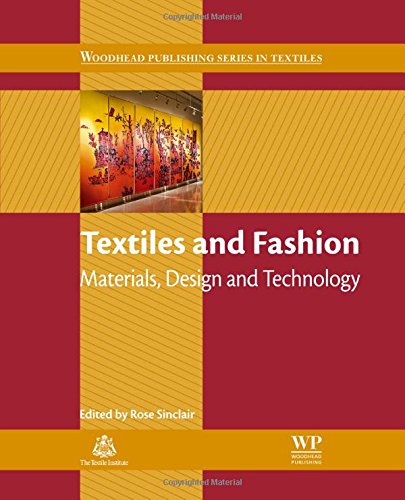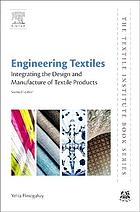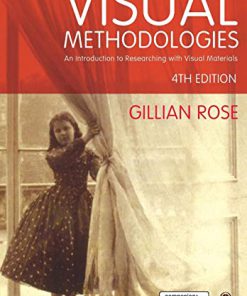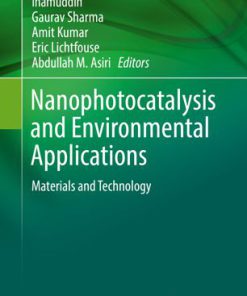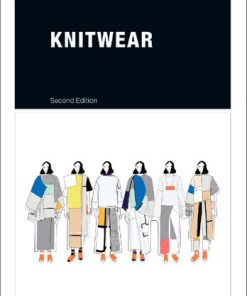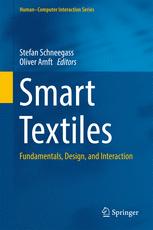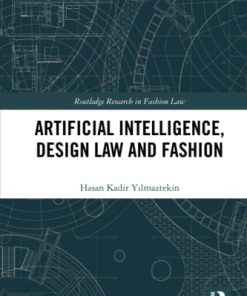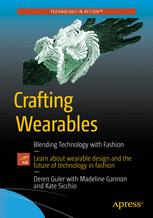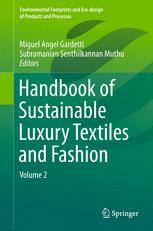Textiles and Fashion Materials Design and Technology 1st Edition by Rose Sinclair ISBN 1845699319 9781845699314
$50.00 Original price was: $50.00.$25.00Current price is: $25.00.
Textiles and Fashion Materials Design and Technology 1st Edition by Rose Sinclair – Ebook PDF Instant Download/Delivery: 1845699319, 9781845699314
Full download Textiles and Fashion Materials Design and Technology 1st Edition after payment
Product details:
ISBN 10: 1845699319
ISBN 13: 9781845699314
Author: Rose Sinclair
This major textbook is designed for students studying textiles and fashion at higher and undergraduate level, as well as those needing a comprehensive and authoritative overview of textile materials and processes. The first part of the book reviews the main types of natural and synthetic fibres and their properties. Part two provides a systematic review of the key processes involved first in converting fibres into yarns and then transforming yarns into fabrics. Part three discusses the range of range of finishing techniques for fabrics. The final part of the book looks specifically at the transformation of fabric into apparel, from design and manufacture to marketing. With contributions from leading experts in their fields, this major book provides the definitive one-volume guide to textile manufacture.
Textiles and Fashion Materials Design and Technology 1st Table of contents:
Part 1. Fibre Types
Chapter 1. Understanding Textile Fibres and Their Properties: What is a Textile Fibre?
Learning Objectives
1.1. Introduction
1.2. Types of Textile Fibres
1.3. Fibres, Yarns and Fabrics
1.4. Fibre Properties
1.5. Fibre Length, Shape and Diameter
1.6. Fibre Colour and Lustre
1.7. Fibre Fineness
1.8. Fibre Strength, Flexibility and Abrasion Resistance
1.9. Moisture Absorbency
1.10. Electrical Properties of Fibres
1.11. Thermal Properties of Fibres
1.12. Chemical Reactivity and Resistance
1.13. Case Studies: From Fibre Properties to Textile Products
1.14. Summary
1.15. Project Ideas
1.16. Revision Questions
Chapter 2. Natural Textile Fibres: Vegetable Fibres
Learning Objectives
2.1. Introduction
2.2. Cotton
2.3. Other Seed Fibres
2.4. Bast Fibre
2.5. Other Bast Fibres
2.6. Sustainability Issues/Eco Issues
2.7. Case Studies
2.8. Future Trends
2.9. Summary
2.10. Project Ideas
2.11. Revision Questions
Chapter 3. Natural Textile Fibres: Animal and Silk Fibres
Learning Objectives
3.1. Introduction
3.2. Wool Fibres
3.3. Silk Fibres
3.4. Other Specialty Hair Fibres
3.5. Applications of Natural Protein Fibres
3.6. Sustainability and Ecological Issues
3.7. Future Trends
3.8. Summary
3.9. Project Ideas
3.10. Revision Questions
Chapter 4. Synthetic Textile Fibers: Regenerated Cellulose Fibers
Learning Objectives
4.1. Introduction
4.2. Viscose Rayon
4.3. Lyocell Rayon
4.4. Cellulose Acetate
4.5. Applications
4.6. Case Study
4.7. Future Trends
4.8. Summary
4.9. Project Ideas
4.10. Revision Questions
Chapter 5. Synthetic Textile Fibres: Polyamide, Polyester and Aramid Fibres
Learning Objectives
5.1. Introduction
5.2. Classification of Fibres
5.3. Polyamide Fibres
5.4. Polyester Fibres
5.5. Aramid Fibres
5.6. Blended Fibres: Key Issues
5.7. Case Study: Polyester Fibres for Apparel and Clothing Applications
5.8. Future Trends
5.9. Summary
5.10. Project Ideas
5.11. Revision Questions
5.12. Sources of Further Information and Advice
Chapter 6. Synthetic Textile Fibres: Polyolefin, Elastomeric and Acrylic Fibres
Learning Objectives
6.1. Introduction
6.2. Polypropylene (PP) Fibres
6.3. Other Polyolefin Fibres
6.4. Acrylic Fibres
6.5. Modacrylic Fibres
6.6. Elastomeric Fibres
6.7. Case Study: Why are There So Many End-Uses for Polypropylene (PP) Fibres, but So Few in Apparel?
6.8. Future Trends
6.9. Summary
6.10. Project Ideas
6.11. Revision Questions
6.12. Sources of Further Information and Advice
Chapter 7. Synthetic Textile Fibres: Non-polymer Fibres
Learning Objectives
7.1. Introduction
7.2. Carbon Fibres
7.3. Glass Fibres
7.4. Metallic Fibres
7.5. Ceramic Fibres
7.6. Case Study: The Use of CFRP in Sporting Goods
7.7. Future Trends
7.8. Summary Points
7.9. Project Ideas
7.10. Revision Questions
Part 2. Manufacturing Textiles: Yarn to Fabric
Chapter 8. Conversion of Fibre to Yarn: An Overview
Learning Objectives
8.1. Introduction
8.2. Classification of Yarns
8.3. Staple-Fibre Yarns
8.4. Filament Yarns
8.5. Fancy Yarns
8.6. Staple-Fibre Yarn Manufacturing
8.7. Future Trends
8.8. Summary
8.9. Project Ideas
8.10. Revision Questions
Chapter 9. Fibre to Yarn: Staple-Yarn Spinning
Learning Objectives
9.1. Introduction
9.2. Preparation of Cotton and Other Short Staple Fibres
9.3. Preparation of Wool and Other Long Staple Fibres: The Woollen System
9.4. Preparation of Wool and Other Long Staple Fibres: The Worsted System
9.5. Spinning Techniques for Staple Fibres
9.6. Wrap-Spinning Techniques
9.7. Future Trends
9.8. Summary Points
9.9. Project Ideas
9.10. Revision Questions
Chapter 10. Fibre to Yarn: Filament Yarn Spinning
Learning Objectives
10.1. Introduction
10.2. Fibre-Extrusion Spinning
10.3. Yarn Texturing
10.4. Bulk Continuous Fibre (BCF) Technology
10.5. Properties of CF Yarns
10.6. Adding Functionality to Yarn
10.7. Applications
10.8. Future Trends
10.9. Project Ideas
10.10. Revision Questions
Chapter 11. Yarn to Fabric: Weaving
Learning Objectives
11.1. Introduction
11.2. Looms
11.3. Making a Warp and Dressing the Loom
11.4. Documentation
11.5. Pattern Drafting
11.6. Weave Structures
11.7. Derivative-Weave Structures
11.8. Starting to Weave
11.9. Designing for Woven Textiles
11.10. Designing for the Jacquard Loom
11.11. Tapestry Weaving
11.12. Case Study: Honeycomb Woven Structures
11.13. Finishing
11.14. Tips for Weaving
11.15. Future Trends
11.16. Summary
11.17. Revision Questions
11.18. Sources of Further Information and Advice
Chapter 12. Yarn to Fabric: Knitting
Learning Objectives
12.1. Introduction
12.2. Loop Formation
12.3. Knitting Terminology
12.4. Weft-Knitted Structures
12.5. Warp Knitted Structures
12.6. Knitting Developments
12.7. The Impact of Computers in Design and Technology
12.8. Quality Control
12.9. Case Study
12.10. Future Trends
12.11. Summary
12.12. Project Ideas
12.13. Revision Questions
12.14. Sources of Further Information and Advice
Chapter 13. Fibre to Fabric: Nonwoven Fabrics
Learning Objectives
13.1. Introduction
13.2. Technologies for the Formation of Nonwoven Fabrics
13.3. Characteristics of Nonwoven Fabric Structure and Properties
13.4. Properties and Performance of Nonwoven Fabrics
13.5. Methods for the Evaluation of Nonwoven Fabric Structure, Properties and Performance
13.6. Nonwoven Fabrics and Their Applications
13.7. Nonwoven Fabrics in Fashion
13.8. Future Trends
13.9. Project Ideas
13.10. Revision Questions
13.11. Sources of Further Information
Chapter 14. Yarn to Fabric: Specialist Fabric Structures
Learning Objectives
14.1. Introduction
14.2. Triaxial Fabrics
14.3. Pile Fabrics
14.4. Knotted Fabrics
14.5. Braided Fabrics
14.6. Three-Dimensional Fabrics And Future Developments
14.7. Summary
14.8. Project Ideas
14.9. Revision Questions
Chapter 15. Yarn to Fabric: Intelligent Textiles
Learning Objectives
15.1. Introduction
15.2. What Are Intelligent Textiles Used For?
15.3. Case Study: Biomimetics and Intelligent Textiles
15.4. Future Trends
15.5. Summary
15.6. Project Ideas
15.7. Revision Questions
15.8. Sources of Further Information And Advice
Part 3. Fabric Finishing and Applications
Chapter 16. Fabric Finishing: Joining Fabrics Using Stitched Seams
Learning Objectives
16.1. Introduction
16.2. The Stitch
16.3. The Seam
16.4. Sewing Machines
16.5. Seam Quality Problems
16.6. Future Trends
16.7. Summary
16.8. Case Study and Project Idea
16.9. Revision Questions
Chapter 17. Joining Fabrics: Fastenings
Learning Objectives
17.1. Introduction
17.2. Zips
17.3. Buttons
17.4. Hook-and-Loop FastenERS
17.5. Press Fasteners
17.6. Cords, Ties and Belts
17.7. Hook-and-Eye Fasteners
17.8. Hook-and-Bar Fasteners
17.9. Buckles and Adjustable Fasteners
17.10. Summary
17.11. Project Ideas
17.12. Revision Questions
17.13. Sources of Further Information
Chapter 18. Fabric Finishing: Pretreatment/Textile Wet Processing
Learning Objectives
18.1. Introduction
18.2. Processing Methods
18.3. Fabric Preparation Processes
18.4. Quality Control in Fabric Preparation
18.5. Environmental Impact and Sustainability of Fabric Preparation
18.6. Research and Future Trends
18.7. Summary
18.8. Case Study
18.9. Project Ideas
18.10. Revision Questions
18.11. Sources of Further Information
Chapter 19. Fabric Finishing: Dyeing and Colouring
Learning Objectives
19.1. Introduction
19.2. Colour Theory
19.3. Selection of Dyes
19.4. The Dyeing Process
19.5. Classes of Dye for Different Fibre Types
19.6. Strengths and Weaknesses of Natural and Synthetic Dyes
19.7. Ensuring Quality and Effectiveness of Dyeing
19.8. Environmental Impact of Dyeing
19.9. Research and Future Trends
19.10. Summary
19.11. Case Study: Reactive Dyeing of Knitted Cotton Garments
19.12. Project Ideas
19.13. Revision Questions
19.14. Sources of Further Information
Chapter 20. Fabric Finishing: Printing Textiles
Learning Objectives
20.1. Introduction
20.2. Direct Printing
20.3. Other Printing Techniques
20.4. Traditional Printing Methods
20.5. Screen Printing
20.6. Transfer Printing
20.7. Digital Inkjet Printing
20.8. Impact of CAD/CAM on the Design of Printed Textiles
20.9. Research and Future Trends
20.10. Summary
20.11. Case Study
20.12. Project Ideas
20.13. Revision Questions
20.14. Sources of Further Information and Advice
Chapter 21. Applications of Textile Products
Learning Objectives
21.1. Introduction
21.2. Apparel
21.3. Furnishing or Interior Textiles, Including Household Products
21.4. Technical Textiles
21.5. Textile Art
21.6. Textile Industry
21.7. Case Study: Traditional Bedouin al Sadu Hand-Woven Products and Contemporary Digital Applications
21.8. Future Trends
21.9. Summary
21.10. Revision Questions
21.11. Sources of Information
Chapter 22. Sustainable Textile Production
Learning Objectives
22.1. Introduction
22.2. Key Issues in Sustainability
22.3. The Textile Supply Chain
22.4. Assessing the Environmental Impact of the Textile Supply Chain
22.5. Minimising the Environmental Impact of the Textile Supply Chain
22.6. Case Study: Creating Sustainable and Socially Responsible Fashion
22.7. Summary and Project Ideas
22.8. Sources of Further Information and Advice
Part 4. Developing Textile Products: The Case of Apparel
Chapter 23. Material Culture: Social Change, Culture, Fashion and Textiles in Europe
Learning Objectives
23.1. Introduction
23.2. Art and Society
23.3. Politics
23.4. War
23.5. Impact of Culture on Design, Fashion and Textiles
23.6. Definitions of Textile Culture and Fashion Culture: Are They the Same?
23.7. Project Ideas
23.8. Revision Questions
23.9. Further Reading
Chapter 24. Fashion and Culture: Global Culture and Fashion
Learning Objectives
24.1. Introduction
24.2. Impact of Culture in European and non-European Arenas
24.3. Case Study
24.4. Future Trends
24.5. Summary Points
24.6. Project Ideas
24.7. Revision Questions
24.8. Further Reading
Chapter 25. Fashion and the Fashion Industry
Learning Objectives
25.1. Introduction
25.2. Emergence, Development and Change in Fashion
25.3. The Standard Fashion-Trend Cycle
25.4. Why Fashion Changes?
25.5. Revision Questions
25.6. Summary Points
Magazines/Periodicals
Chapter 26. Visual Design Techniques for Fashion
Learning Objectives
26.1. Introduction
26.2. Why Consumers Buy New Designs
26.3. Market Research Methods for Identifying Emerging Consumer Needs
26.4. Finding Inspiration
26.5. Aesthetic Qualities in a Good Design
26.6. Design Tools
26.7. Moving from Sample to Production
26.8. Future Trends: Impact of New Technologies/Processes
26.9. Case Study: The Development of a Garment
26.10. Summary
26.11. Project Ideas
26.12. Revision Questions
26.13. Sources of Further Information and Advice
Chapter 27. Computer-Aided Design (CAD) and Computer-Aided Manufacturing (CAM) of Apparel and other Textile Products
Learning Objectives
27.1. Introduction
27.2. Fashion and Textile Software Programs
27.3. Using CAD to Design Fashion Products
27.4. Other Uses of CAD in Fashion Design
27.5. CAM in Fashion and Textiles
27.6. Case Studies: Fashion Designers Interviewed by Sandra Burke
27.7. Summary Points and Project Ideas
27.8. Revision Questions
27.9. Sources of Further Information and Advice
Chapter 28. Adding Functionality to Garments
Learning Objectives
28.1. Introduction
28.2. Factors Affecting Garment Function
28.3. Improving Fabric Handle and Tailorability
28.4. Reducing Wrinkling
28.5. Reducing Pilling
28.6. Reducing Bagging
28.7. Improving Fabric and Garment Drape
28.8. Improving Fabric and Garment Durability
28.9. Research and Future Trends
28.10. Summary
28.11. Project Ideas
28.12. Revision Questions
Chapter 29. Improving the Comfort of Garments
Learning Objectives
29.1. Introduction
29.2. Tactile Comfort
29.3. Thermo-Physiological (Thermal) Comfort
29.4. Measuring Physiological Comfort
29.5. Psychological Comfort
29.6. Improving Waterproofing and Breathability
29.7. Research and Future Trends
29.8. Summary
29.9. Case Study
29.10. Project Ideas
29.11. Revision Questions
Chapter 30. The Marketing of Fashion
Learning Objectives
30.1. Introduction
30.2. What Is Marketing?
30.3. The Marketing of Fashion
30.4. Targeting a Market
30.5. Branding
30.6. The Traditional Media Channels
30.7. New Technologies as Media Channels
30.8. The Marketing Plan
30.9. Future Trends
30.10. Summary Points
30.11. Project Ideas and Revision Questions
30.12. Sources of Further Information
Chapter 31. The Care of Apparel Products
31.1. Introduction
31.2. Wear of Garments
31.3. Stains
31.4. Laundering
31.5. Care Labelling
31.6. Clothing Storage
31.7. Conclusions and Future Trends
31.8. Sources of Further Information
31.9. Summary Points
31.10. Project Ideas
31.11. Revision Questions
People also search for Textiles and Fashion Materials Design and Technology 1st:
textiles and fashion materials design and technology
textiles and fashion materials design and technology pdf
textiles and fashion materials design and technology by rose sinclair
what is textile technology and design
what is textiles and design
Tags:
Rose Sinclair,Textiles,Fashion Materials,Design,Technology
You may also like…
Engineering
Uncategorized
Engineering - Bioengineering
Nanophotocatalysis and Environmental Applications Materials and Technology Inamuddin
Housekeeping & Leisure - Handicraft
Basics fashion design Knitwear Second Revised Edition Juliana Sissons
Engineering - Industrial Engineering & Materials Science
Jurisprudence & Law - Intellectual Property
Artificial Intelligence Design Law and Fashion 1st Edition by Yilmaztekin 1000818796 9781000818796
Engineering
Handbook of Sustainable Luxury Textiles and Fashion Volume 2 1st Edition Miguel Angel Gardetti


